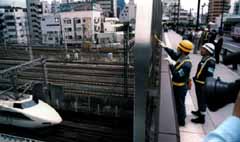|
Science & Technology || Sports & Fashion || Search || Back Numbers
EXPRESS TRAIN CRASH IN GERMANY: A Lesson for All July 31, 1998  Japanese railway workers check an overpass, keeping it safe for the "bullet train" below. (Kyodo) Leaving over 100 people dead, the June 3, 1998, derailing of a German Intercity Express (ICE) high-speed passenger train gave quite a shock to railway authorities in Japan. Particularly shaken were Japan Railway (JR) companies, which operate their Shinkansen super-express trains (often called "bullet trains") at speeds of 200 to 300 kilometers (125 to 185 miles) per hour, on schedules timed down to the minute. Emergency inspections are being conducted on all Shinkansen trains and detailed information on the cause of the ICE crash is being compiled by these companies to help ensure future safety. Immediate Inspection of Trains, Crossings The ICE accident occurred when the train was traveling at 200 kph (125 mph). All cars except for the lead engine derailed, smashing into the concrete supports of an overpass and coming to rest in a mangled heap. A broken wheel on the first passenger car has been fingered as the direct cause of the accident. News of the catastrophe was taken very seriously by JR companies, which immediately implemented safety checks on their railways, conducting complete inspections of all Shinkansen cars and elevated crossings. Japan's Shinkansen trains began operation in 1964. In over 30 years of operations, the Shinkansen have recorded no fatal accidents among their more than 3 billion passengers. This legendary safety is supported by a multi-layered inspection and operation system. Regular inspections of the wheels, axles, chassis, and other parts keep trains in good working condition. There are four levels of inspection: those conducted every 2 days, every 30 days or 30,000 kilometers' (18,500 miles') traveling distance, once a year or every 450,000 kilometers (280,000 miles), and every three years or 900,000 kilometers (560,000 miles). Trains are inspected visually and by using ultrasonic and magnetic techniques to check for internal damage at the microscopic level. Old wheels are replaced every three years or 1.5 million kilometers (930,000 miles). In 34 years of Shinkansen operation, there has been only one instance of damage to a train undercarriage--a faulty axle. If deformation or damage to a moving train's wheel causes it to rotate irregularly, a signal lights up on the conductor's operation panel telling the conductor to apply the brakes. Axles, too, are under constant watch by sensors that will bring the train to a halt if any abnormality with the bearings or other parts raises friction heat to above 140 degrees centigrade (284 Fahrenheit). In addition to the train carriages themselves, the tracks are also inspected for safety. Specialized maintenance cars ride the tracks daily, making sure that trains can run with no problem. Every ten days an inspection train checks irregularities. An Automatic Train Control (ATC) device is also employed to control the speed of the trains, monitoring the distance between any two trains as well as track conditions. Safety in a World of 300-kph TrainsAlthough each Shinkansen is equipped with world-class, advanced operational systems and is kept in working order with sophisticated maintenance and repair technology, this does not mean that safety measures are infallible. When they first started operating, the maximum passenger-carrying speed allowed for these trains was 210 kph (130 mph). Strong competition with airlines, however, has led the JR companies to develop new Shinkansen models, each designed for faster speeds. Trains running at 300 kph (185 mph) were put into service in March 1997, and research has begun on magnetically levitated trains that will eventually go 500 kph (310 mph). The faster trains travel, the more they shake and vibrate, imposing a greater load on the wheels and axles. Experts point out that at very high speeds, even a tiny flaw may result in a catastrophic breakdown. Preparing for earthquakes, too, gives railway authorities cause for concern. Shinkansen railways employ an emergency braking system that is triggered when an earthquake occurs. The faster the train is moving, however, the longer the braking distance--and a longer braking distance means more time during which a moving train can actually be shaken by an earthquake. The recent ICE train crash in Germany is a strong reminder of the difficulties inherent in attempting to balance speed and safety, and Japanese railway operators are working to learn their lessons.
 Edited by Japan
Echo Inc. based on domestic Japanese news sources. Articles
presented here are offered for reference purposes and do not
necessarily represent the policy or views of the Japanese
Government. Edited by Japan
Echo Inc. based on domestic Japanese news sources. Articles
presented here are offered for reference purposes and do not
necessarily represent the policy or views of the Japanese
Government.
|
